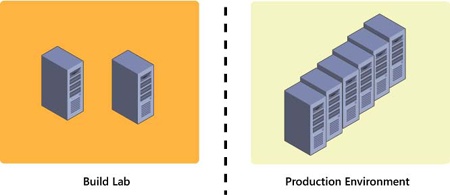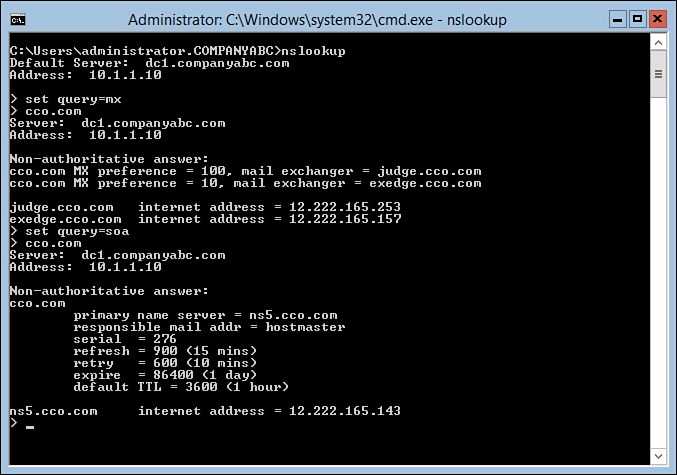Using the Ipconfig Command-Line Utility
Another important tool for DNS resolution problems is the Ipconfig utility, the same utility used for common TCP/IP issues. There are several key functions that Ipconfig offers with regard to DNS. These functions can be invoked from the command prompt with the right parameter, detailed as follows:
• ipconfig /flushdns—If you experience problems with the client-side cache, the cache itself can be “flushed” through the invocation of the flushdns flag. This removes all previously cached queries that a client might be storing and is particularly useful if a server name has just changed IP addresses and particular clients have trouble connecting to it.
• ipconfig /registerdns—The registerdns flag forces the client to dynamically reregister itself in DNS, if the particular zone supports dynamic updates.
• ipconfig /displaydns—An interesting but not well-known parameter is displaydns. This flag displays the contents of the client-side cache and is useful for troubleshooting specific issues with individual records.
Using the Tracert Command-Line Utility
The Tracert utility is a valuable resource that gives you an idea of the path that a DNS query takes when being sent over a network. By directing Tracert at www.microsoft.com, for example, you can get an idea of how many routers and DNS servers the packet is crossing. The way that Tracert works is simple, but actually quite interesting. A DNS query that has a TTL of 1 is sent out. Because all routers are supposed to drop the TTL by 1 on each packet that they process, this means that the first router will refuse to forward the packet and send that refusal back to the originator. The originating machine then increments the TTL by 1 and resends the packet. This time the packet will make it past the first router and get refused by the second. This process continues until the destination is met. Needless to say, using this command-line utility is a simple yet effective way of viewing the path that a DNS query takes as it crosses the Internet.
Using the DNSCmd Command-Line Utility
The DNSCmd utility is essentially a command-line version of the DNS Manager console. Installed as part of the Windows Server 2012 DNS Server role, this utility enables administrators to create zones, modify records, and perform other vital administrative functions via the command line. You can view the full functionality of this utility by typing dnscmd /? at the command line, as illustrated in Listing 2.
Listing 2. DNSCMD Command Options
Usage: DnsCmd <ServerName> <Command> [<Command Parameters>]
<ServerName>:
IP address or host name — remote or local DNS server
. — DNS server on local machine
<Command>:
/Info — Get server information
/Config — Reset server or zone configuration
/EnumZones — Enumerate zones
/Statistics — Query/clear server statistics data
/ClearCache — Clear DNS server cache
/WriteBackFiles — Write back all zone or root-hint datafile(s)
/StartScavenging — Initiates server scavenging
/IpValidate — Validate remote DNS servers
/EnumKSPs — Enumerate available key storage providers
/ResetListenAddresses — Set server IP address(es) to serve DNS requests
/ResetForwarders — Set DNS servers to forward recursive queries to
/ZoneInfo — View zone information
/ZoneAdd — Create a new zone on the DNS server
/ZoneDelete — Delete a zone from DNS server or DS
/ZonePause — Pause a zone
/ZoneResume — Resume a zone
/ZoneReload — Reload zone from its database (file or DS)
/ZoneWriteBack — Write back zone to file
/ZoneRefresh — Force refresh of secondary zone from master
/ZoneUpdateFromDs — Update a DS integrated zone by data from DS
/ZonePrint — Display all records in the zone
/ZoneResetType — Change zone type
/ZoneResetSecondaries — Reset secondary\notify information for a zone
/ZoneResetScavengeServers — Reset scavenging servers for a zone
/ZoneResetMasters — Reset secondary zone’s master servers
/ZoneExport — Export a zone to file
/ZoneChangeDirectoryPartition — Move a zone to another directory partition
/ZoneSeizeKeymasterRole — Seize the key master role for a zone
/ZoneTransferKeymasterRole — Transfer the key master role for a zone
/ZoneEnumSKDs — Enumerate the signing key descriptors for a zone
/ZoneAddSKD — Create a new signing key descriptor for a zone
/ZoneDeleteSKD — Delete a signing key descriptor for a zone
/ZoneModifySKD — Modify a signing key descriptor for a zone
/ZoneValidateSigningParameters — Validate DNSSEC online signing parameters for a
zone
/ZoneSetSKDState — Set Active and/or Standby keys for a signing key
descriptor for a zone
/ZoneGetSKDState — Retrieve dynamic state for a signing key descriptor
for a zone
/ZonePerformKeyRollover — Trigger a key rollover in a signing key descriptor
for a zone
/ZonePokeKeyRollover — Trigger a key rollover in a signing key descriptor
for a zone
/ZoneSign — Signs the zone using DNSSEC online signing parameters
/ZoneUnsign — Removes DNSSEC signatures from a signed zone
/ZoneResign — Regenerate DNSSEC signatures in a signed zone
/EnumRecords — Enumerate records at a name
/RecordAdd — Create a record in zone or RootHints
/RecordDelete — Delete a record from zone, RootHints or cache
/NodeDelete — Delete all records at a name
/AgeAllRecords — Force aging on node(s) in zone
/TrustAnchorAdd — Create a new trust anchor zone on the DNS server
/TrustAnchorDelete — Delete a trust anchor zone from DNS server or DS
/EnumTrustAnchors — Display status information for trust anchors
/TrustAnchorsResetType — Change zone type for a trust anchor zone
/EnumDirectoryPartitions — Enumerate directory partitions
/DirectoryPartitionInfo — Get info on a directory partition
/CreateDirectoryPartition — Create a directory partition
/DeleteDirectoryPartition — Delete a directory partition
/EnlistDirectoryPartition — Add DNS server to partition replication scope
/UnenlistDirectoryPartition — Remove DNS server from replication scope
/CreateBuiltinDirectoryPartitions — Create built-in partitions
/ExportSettings — Output settings to DnsSettings.txt in the DNS server
database directory
/OfflineSign — Offline signing zone files, including key genera-
tion/deletion
/EnumTrustPoints — Display active refresh information for all trust
points
/ActiveRefreshAllTrustPoints — Perform an active refresh on all trust points now
/RetrieveRootTrustAnchors — Retrieve root trust anchors via HTTPS
<Command Parameters>:
DnsCmd <CommandName> /? — For help info on specific Command
In future versions of Windows, Microsoft might remove dnscmd.exe.
If you currently use dnscmd.exe to configure and manage the DNS server, Microsoft recommends that you transition to Windows PowerShell.
To view a list of commands for DNS server management, type Get-Command -Module DnsServer at the Windows PowerShell prompt. Additional information about Windows PowerShell commands for DNS is available at http://go.microsoft.com/fwlink/?LinkId=217627.
Managing DNS with PowerShell
The PowerShell cmdlets are essentially a command-line version of the DNS Manager console. Installed as part of the Windows Server 2012 DNS Server role, this PowerShell module enables administrators to create zones, modify records, and perform other vital administrative functions via the command line exactly as can be done with the traditional DNSCmd tool. DNS configuration and management automation is greatly enhanced with Windows PowerShell, including the following:
• Feature parity with the user interface and DNSCmd.
• DNS Server role installation/removal using Windows PowerShell.
• Windows PowerShell client query with DNSSEC validation results.
• Server configuration is enabled for computers running older operating systems.
You can view the full functionality of this utility by typing Get-Command -Module DnsServer at the PowerShell command line, as shown in Listing 3.
Listing 3. PowerShell DNS Cmdlets
CommandType Name ModuleName
———– —- ———-
Alias Export-DnsServerTrustAnchor DnsServer
Function Add-DnsServerConditionalForwarderZone DnsServer
Function Add-DnsServerDirectoryPartition DnsServer
Function Add-DnsServerForwarder DnsServer
Function Add-DnsServerPrimaryZone DnsServer
Function Add-DnsServerResourceRecord DnsServer
Function Add-DnsServerResourceRecordA DnsServer
Function Add-DnsServerResourceRecordAAAA DnsServer
Function Add-DnsServerResourceRecordCName DnsServer
Function Add-DnsServerResourceRecordDnsKey DnsServer
Function Add-DnsServerResourceRecordDS DnsServer
Function Add-DnsServerResourceRecordMX DnsServer
Function Add-DnsServerResourceRecordPtr DnsServer
Function Add-DnsServerRootHint DnsServer
Function Add-DnsServerSecondaryZone DnsServer
Function Add-DnsServerSigningKey DnsServer
Function Add-DnsServerStubZone DnsServer
Function Add-DnsServerTrustAnchor DnsServer
Function Add-DnsServerZoneDelegation DnsServer
Function Clear-DnsServerCache DnsServer
Function Clear-DnsServerStatistics DnsServer
Function ConvertTo-DnsServerPrimaryZone DnsServer
Function ConvertTo-DnsServerSecondaryZone DnsServer
Function Disable-DnsServerSigningKeyRollover DnsServer
Function Enable-DnsServerSigningKeyRollover DnsServer
Function Export-DnsServerDnsSecPublicKey DnsServer
Function Export-DnsServerZone DnsServer
Function Get-DnsServer DnsServer
Function Get-DnsServerCache DnsServer
Function Get-DnsServerDiagnostics DnsServer
Function Get-DnsServerDirectoryPartition DnsServer
Function Get-DnsServerDnsSecZoneSetting DnsServer
Function Get-DnsServerDsSetting DnsServer
Function Get-DnsServerEDns DnsServer
Function Get-DnsServerForwarder DnsServer
Function Get-DnsServerGlobalNameZone DnsServer
Function Get-DnsServerGlobalQueryBlockList DnsServer
Function Get-DnsServerRecursion DnsServer
Function Get-DnsServerResourceRecord DnsServer
Function Get-DnsServerRootHint DnsServer
Function Get-DnsServerScavenging DnsServer
Function Get-DnsServerSetting DnsServer
Function Get-DnsServerSigningKey DnsServer
Function Get-DnsServerStatistics DnsServer
Function Get-DnsServerTrustAnchor DnsServer
Function Get-DnsServerTrustPoint DnsServer
Function Get-DnsServerZone DnsServer
Function Get-DnsServerZoneAging DnsServer
Function Get-DnsServerZoneDelegation DnsServer
Function Import-DnsServerResourceRecordDS DnsServer
Function Import-DnsServerRootHint DnsServer
Function Import-DnsServerTrustAnchor DnsServer
Function Invoke-DnsServerSigningKeyRollover DnsServer
Function Invoke-DnsServerZoneSign DnsServer
Function Invoke-DnsServerZoneUnsign DnsServer
Function Register-DnsServerDirectoryPartition DnsServer
Function Remove-DnsServerDirectoryPartition DnsServer
Function Remove-DnsServerForwarder DnsServer
Function Remove-DnsServerResourceRecord DnsServer
Function Remove-DnsServerRootHint DnsServer
Function Remove-DnsServerSigningKey DnsServer
Function Remove-DnsServerTrustAnchor DnsServer
Function Remove-DnsServerZone DnsServer
Function Remove-DnsServerZoneDelegation DnsServer
Function Reset-DnsServerZoneKeyMasterRole DnsServer
Function Restore-DnsServerPrimaryZone DnsServer
Function Restore-DnsServerSecondaryZone DnsServer
Function Resume-DnsServerZone DnsServer
Function Set-DnsServer DnsServer
Function Set-DnsServerCache DnsServer
Function Set-DnsServerConditionalForwarderZone DnsServer
Function Set-DnsServerDiagnostics DnsServer
Function Set-DnsServerDnsSecZoneSetting DnsServer
Function Set-DnsServerDsSetting DnsServer
Function Set-DnsServerEDns DnsServer
Function Set-DnsServerForwarder DnsServer
Function Set-DnsServerGlobalNameZone DnsServer
Function Set-DnsServerGlobalQueryBlockList DnsServer
Function Set-DnsServerPrimaryZone DnsServer
Function Set-DnsServerRecursion DnsServer
Function Set-DnsServerResourceRecord DnsServer
Function Set-DnsServerResourceRecordAging DnsServer
Function Set-DnsServerRootHint DnsServer
Function Set-DnsServerScavenging DnsServer
Function Set-DnsServerSecondaryZone DnsServer
Function Set-DnsServerSetting DnsServer
Function Set-DnsServerSigningKey DnsServer
Function Set-DnsServerStubZone DnsServer
Function Set-DnsServerZoneAging DnsServer
Function Set-DnsServerZoneDelegation DnsServer
Function Show-DnsServerCache DnsServer
Function Show-DnsServerKeyStorageProvider DnsServer
Function Start-DnsServerScavenging DnsServer
Function Start-DnsServerZoneTransfer DnsServer
Function Suspend-DnsServerZone DnsServer
Function Sync-DnsServerZone DnsServer
Function Test-DnsServer DnsServer
Function Test-DnsServerDnsSecZoneSetting DnsServer
Function Unregister-DnsServerDirectoryPartition DnsServer
Function Update-DnsServerTrustPoint DnsServer


